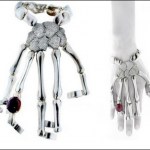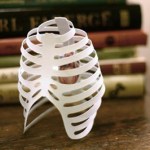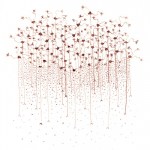anatomy
Okay, these dolls by David Foox are just plain disturbing. And they're not just a concept - you can actually BUY ONE.
Via Street Anatomy.
Gallup has taken on the task of explaining, in ultimate terms, the evolutionarily designed features of the human penis. He works this as an engineering problem from the perspective of evolutionary psychology, which is always a little bit dangerious, but gallup isn't quite the arm waiver that a lot of other EP's are, so he may be doing it right.
Gallup's work is written up an an all-too-sophomoric Scientific American article by Jesse Bering which just barely falls short of explaining this important biological phenomenon in terms of a pair of headlights, a flashlight, and a little red waagon.…
Christmas greeting card, school unknown, circa 1920.
Dittrick Medical History Center
from Dissection: Photographs of a Rite of Passage in American Medicine 1880-1930
Slate has an intriguing new review by Barron Lerner of a book called Dissection: Photographs of a Rite of Passage in American Medicine 1880-1930, by John Harley Warner and James M. Edmonson. The book delves into the turn-of-the-century practice of photographing medical students with cadavers - photos that today read as weird, grotesque, even offensive.
The photos unearthed by Warner and Edmonson depict an astonishing variety of…
Jewelry designer Delfina Delettrez is young, a fourth-generation member of the Fendi family, and apparently obsessed with anatomy. Her most intriguing creation is a Skeletor-like carpal gauntlet:
The silver hand will cost you about $24K. If you haven't got that much disposable income, she also does smaller pieces: earrings and necklaces inspired by eyes, lips, spiders, cephalopods, frogs, etc. They're pretty, but I keep coming back to that hand and thinking it's so cynically appropriate to put a bony skeleton hand on a fashion model.
Found via haute macabre
I know this will be of interesting for about 1 in a hundred of you, but there is a REALLY good review of hippocampal and parahippocampal region connectivity in April's Nature Review Neuroscience. Of special interest, there is an interactive .pdf in the supplementary information where you can identify the connections between one region to every other region. Also, they discuss the functions of the entorhinal cortex and the subiculum from the point of view of update anatomy.
(Unfortunately behind a subscription wall, but I feel confident that anyone who understood a word of what I just said…
The Sleeping Venus (1944)
Paul Delvaux
Observatory is a new collaborative art space located in Brooklyn, where it is reportedly sandwiched between Proteus Gowanus, Cabinet Magazine, and the Morbid Anatomy library. Its illustrious proprietors include Pam of Phantasmaphile, Joanna of Morbid Anatomy, and D&M of Curious Expeditions. And if that's not reason enough to be excited, tonight they are hosting a talk by Kathryn Hoffmann of the University of Hawaii at Manoa, entitled "Reveries of Sleeping Beauty: Slumber and Death in Anatomical Museums, Fairground Shows, and Art."
I saw Dr. Hoffmann…
Via Morbid Anatomy: the Discovery Channel series "How It's Made" features the construction of modern anatomical models. You can watch the five-minute segment after the fold.
Discovery Channel, "How It's Made", Season 11, Episode 2/Part 1
This revealing anatomical card by Oregon designer Nathan Chrislip can be had for only $9 plus shipping on etsy. (Chrislip calls it a "valentine," but unless your beloved is also an avowed anatomophile, be sure to enclose a message making your nonviolent romantic intent clear.)
Via Rag and Bone Blog
Thought Patterns #1
blood on watercolor paper
Laura Splan, 2003
The International Museum of Surgical Science in Chicago is calling for proposals for "Anatomy in the Gallery:"
[This program] showcases medically themed contemporary art within the unique context of the Museum's historical collections and exhibits. The program was begun in 1998 to help fulfill the Museum's mission of enriching its visitors' lives by enhancing their knowledge and understanding of surgery and related sciences.
Previous exhibitors include Laura Splan (above), Laura Kurtenbach, Geraldine Ondrizek, and Dominic Paul…
Or not.
Much is made of the early use of stone tools by human ancestors. Darwin saw the freeing of the hands ad co-evolving with the use of the hands to make and use tools which co-evolved with the big brain. And that would make the initial appearance of stone tools in the archaeological record a great and momentous thing. However, things did not work out that way.
It turns out that up-rightedness (bipedalism), which would free the hands, evolved in our ancestors a very long time (millions of years) prior to our first record of stone tools. The earliest upright hominids that are…
Allen's Rule. One of those things you learn in graduate school along with Bergmann's Rule and Cope's Rule. It is all about body size. Cope's Rule ... which is a rule of thumb and not an absolute ... says that over time the species in a given lineage tend to be larger and larger. Bergmann's Rule says that mammals get larger in colder environments. Allen's Rule has mammals getting rounder in colder climates, by decreasing length of appendages such as limbs, tails and ears.
All three rules seem to be exemplified in human evolution. Modern humans tend to be larger and rounder in cooler…
Homo floresiensis more widely known as the "Hobbit," may have had arms that were very different from those of modern humans.
A paper in the current issue of the Journal of Human Evolution explores the anatomy of H. floresiensis. To explore this we first have to understand the concept of "Humeral torsion." Humeral torsion is the orientation of the humeral head relative to the mediolateral axis of the distal articular surface. Don't bother reading that sentence again, I'll explain it.
The humerus is the upper arm bone, that runs between your shoulder and your elbow. The humeral head is…
Fossils of a newly discovered species of dinosaur -- a 10-meter-long, elephant-weight predator -- were discovered in 1996 along the banks of Argentina's Rio Colorado, and are now being reported after a long period of careful study. This dinosaur dates to about 85 million years (which falls within the Cretaceous period).
Perhaps the most interesting feature of Aerosteon riocoloradensis is that it demonstrates the evolution of a bird-like respiratory system in an animal that is definitely not bird-like in most other ways. Indeed, the authors of this paper imply that this dinosaur's…
Human societies tend to be at least a little polygynous. This finding, recently reported in PLoS genetics, does not surprise us but is nonetheless important. This important in two ways: 1) This study uncovers numerical details of human genetic variation that are necessary to understand change across populations and over time; and 2) the variation across populations are interesting and, in fact, seem to conform to expectations (in a "we don't' really care about statistical significance" sort of way, for now) regarding human social organization.
Before examining the paper, we should…
How do athletes in Olympic level endurance competition do it?
From the abstract of a paper -- How Do Humans Control Physiological Strain during Strenuous Endurance Exercise?:
To evaluate the physiologic strain during competitions ranging from 5-100 km, we evaluated heart rate (HR) records of competitive runners (n = 211). We found evidence that:
1) physiologic strain (% of maximum HR (%HRmax)) increased in proportional manner relative to distance completed, and was regulated by variations in running pace;
2) the %HRmax achieved decreased with relative distance;
3) slower runners had…
Stephen Jay Gould and David Pilbeam wrote a paper in 1974 that was shown ten years later to be so totally wrong in its conclusions that it has fallen into an obscurity not usually linked to either Gould or Pilbeam. However, they were actually right in ways that they could not have anticipated. And even if they were not right, this paper still has much to contribute, including the opening words of that publication in Science, which are very much worthy of consideration for many reasons:
It is no longer true that there are more practitioners than pieces. In fact, when I encountered this…
Deconstructed and Constructed, but not in the same sentence.
Philip Guston's "Sea," a lithograph on handmade paper from 1980, the year the artist died. Students at Cornell have constructed an exhibit of the art of human body disassembled or otherwise rearranged called Exquisite Corpus: Interacting with the Fragmented Body which is on exhibit through June 15th (details here).
"In contemporary art right now, there are no limits, no boundaries," Hirsch said. "We wanted to show contemporary work, and show that art can be anything, maybe even vulgar."
The title and concept refer to the…
Grrrrrrrrrrrrr....
Welcome to the Lucky 13th Edition of The Boneyard ... the Web Carnival about Bones and Stuff.
"The Boneyard is a blog carnival covering all things paleo, from dinosaurs to pollen to hominids and everywhere in between. It's held every two weeks (the 1st and 3rd Saturday of the month), traveling around to a different blog for each installment, connecting some of the best blogging on ancient life."
The previous edition of The Boneyard is here, at Dragon's Tales. The next edition of The Boneyard will be Here at Archaeozoology. If you would like to submit an entry to the next…
There is an updated version of this post here: "Is Blood Ever Blue, Science Teachers Want To Know!"
According to one of the leading experts on the human circulatory system, blood flowing through veins is blue.
I'm not going to mention any names. All I'll say is this: A person I know visited a major research center last year and saw a demonstration of organ removal and some other experimental stuff. A person also visiting asked the famous high-level researcher doing this work if blood was ever blue. What he said was not recorded in detail, but it was very much like this statement I found…





